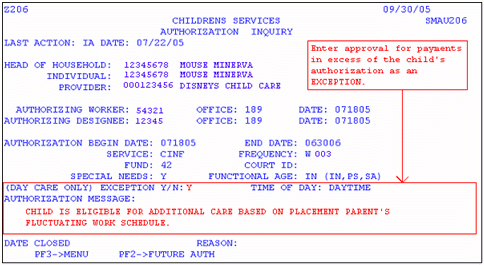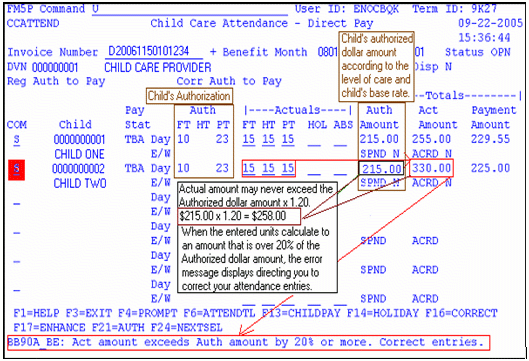ALL REGIONAL AND COUNTY FSD/CD OFFICES
FREDRIC M. SIMMENS, DIRECTOR
CHILDREN'S DIVISION
JANEL R. LUCK, INTERIM DIRECTOR
FAMILY SUPPORT DIVISION
The purpose of this memorandum is to clarify procedures for making payments to providers when days of care exceed the child's authorized dollar amount and explain the programming change to the Direct Pay Invoice screen, FM5P (CCATTEND).
GENERAL PAYMENT PROCEDURES
General Payment Procedures apply to all state paid child care services through FSD and CD. It is the intent of the agency to pay child care services to legal and compliant providers when the provider bills DSS for these services. This is accomplished when the:
- Provider is legal and compliant with Missouri Department of Social Services requirements, and,
- Children are authorized to the provider via the appropriate system, SEAS or FAMIS.
Providers must comply with DSS requirements before reimbursement for care of a Child Welfare (SEAS) placement or eligible low-income child (FAMIS) can be made via CS-65 or invoice.
Legal and compliant status means that a provider:
- Is licensed by Missouri Department of Health and Senior Services/Bureau of Child Care (BOCC) and has a current child care contract with the Department of Social Services/Family Support Division/Children's Division, or,
- Is exempt from licensure (RSMo 210.211) and has a valid exemption in BOCC's MOHSAIC system and is currently registered with DSS/FSD/CD, or,
- Is a legal provider in the provider's home state and registered with Missouri DSS/FSD/CD, when the family utilizes a provider outside of Missouri.
The provider must have a valid payment agreement for the services they are requesting payment. For example:
- A provider who is licensed and contracted for daytime care may not receive payment for evening/weekend care;
- A provider who has a payment agreement to offer full time services shall not be paid for half time or part time services.
When the provider bills for services not specified in their payment agreement:
- Verify the services outlined in the payment agreement by viewing the provider's contract information on ZCVR or their registered provider rate information in FAMIS on FMEC.
- Check the provider's license specifications on the BOCC web page, available on the FSD Intranet as “MOHSAIC,” and verify that the provider's license supports the type of care.
For example, providers who are licensed to care for children ages 2 and older may not be contracted, registered or paid for infant care services.
- When the provider's contract does not match the level of care indicated on their license, give the provider a new facility specific child care contract to complete for services prior to making payment. Submit the completed and signed contract to the Contract Management Unit at Central Office. Modify the child's authorization so that it meets the parent's need schedule and is compliant with the provider's payment agreement.
For example, the provider submits a request for payment of child attendance that occurred from 1:00 p.m. to 8:30p.m. The provider is licensed to care for children from 6.a.m. to 9 p.m. The provider's current contract is for daytime services, which encompasses the DSS designated daytime hours of care from 6 a.m. to 7p.m. Because the provider's license indicates care is legal after 7 p.m., the provider must complete a new contract indicating their rates for daytime and evening/weekend care in order to be paid for care that extends beyond 7 p.m.
- When a license-exempt provider's rates on the rate screen, (FMEC) in FAMIS, do not match the billed services, request that that provider complete a new registration form (IM-91/FA-350) with rates for the billed services. Update the rate screen to include the rates for new levels of care and use the new rates to calculate a manual correction payment to the provider via the Correction screen FM60. Modify the child's authorization so that it meets the parent's need schedule and is compliant with the provider's payment agreement.
In addition to provider compliance, authorization of the child to the provider must occur within the appropriate eligibility system, SEAS or FAMIS. Authorizing children accurately and timely for child care services to compliant providers ensures that child care invoices are accurately generated to providers by FAMIS and SEAS, thus, reducing the need for manual payments.
Payment via CS-65 for Child Welfare Child Care (manual payments) should be a last resort because it increases chances of inaccurate and/or improper payments. Manual payments make reconstruction of payment history and payment validation difficult when determining fraud and improper payment situations.
When prior approval to pay Child Welfare/PS child care services via CS-65 is obtained, staff must verify the provider's compliance prior to submitting the request for payment to Central Office.
No payments shall be made to providers or reimbursements to parents or service placements for care until the caregiver is legal and compliant with Missouri requirements.
PAYMENT TOLERANCE IN SEAS
The tolerance limit on a SEAS invoice is the child's authorization. Any allowance needed to accommodate the child's or placement's needs must be addressed in the exception process of the child's authorization.

The exception indicator is an asterisk that appears after the child's name on a printed SEAS Child Care invoice. This indicator allows payment to exceed the child's authorization when entering attendance from the paper invoice and eliminating the need to request payment via CS-65.
Verify the child attendance before entering attendance in excess of the child's authorization.
PAYMENT TOLERANCE IN FAMIS
The FAMIS payment tolerance limit on FM5P allows local FSD staff to enter child attendance and pay the provider for additional units of care. The intent of the payment tolerance is to allow payment for rare incidents when attendance exceeds the child's authorization. The tolerance limit is not a mechanism to routinely pay for services for which the child is not authorized.
Effective October 11, 2005, the FAMIS payment tolerance limit changes to twenty percent over the authorized dollar amount.
FAMIS SCREEN FUNCTIONALITY
Every child authorized for child care services in FAMIS has an authorized dollar amount attached to the child's authorization on the monthly invoice. The child's authorized dollar amount displays on FM5P (CCATTEND) screen in the 'Auth Amount' field. The child's age, level of authorized care, type of provider, geographic area of the provider, provider's eligibility for rate enhancements, and maximum state rates for the provider determine the child's authorized dollar amount. The tolerance limit is determined by multiplying the child's authorized dollar by 1.20.
FAMIS calculates the attendance entered and compares it to the tolerance limit independently for each child. When submitted child attendance results in a dollar amount that exceeds the 20% tolerance limit, an error message displays directing you to change your attendance entries for the highlighted row.

FAMIS PAYMENT PROCEDURES
Because excess child attendance must be verified before additional payment is made, enter attendance for the authorized amount. To verify the excess attendance, compare the additional care with the verified need schedule of the parent. If the available need schedule does not support the excess care, contact the family to provide an updated need schedule. This verification may come from the employer, school, training program, but not solely from the provider and the parent.
Effective immediately, follow these procedures for making a payment for excess services:
- Enter attendance on FM5P according to the child's authorization,
- Obtain attendance records from the registered or contracted provider,
- Verify that the provider has a payment agreement for the billed services,
- Verify that the parent's schedule supports the need for additional care,
- Obtain verification of the parent's new schedule, if changed,
- Determine parent and provider eligibility for excess services,
- When provider is eligible for payment, enter the units of care that exceed the child's authorization on the Correction Screen, FM60.
- Based on the verification received, adjust the child's authorization accordingly.
- Review with all appropriate staff.
- Validate the provider's compliance prior to making payments to a provider or to a family.
- Ensure that parent eligibility exists prior to making payment for excess services.
- Modify child authorizations accordingly.
FMS/JRL/DE